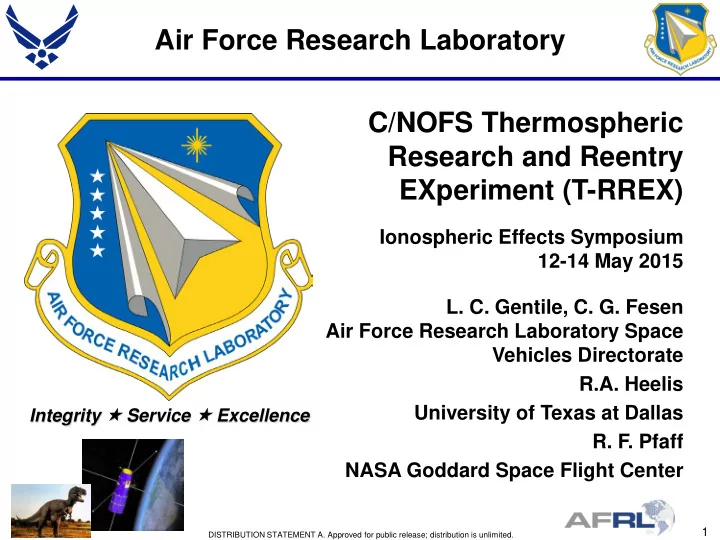

Air Force Research Laboratory C/NOFS Thermospheric Research and Reentry EXperiment (T-RREX) Ionospheric Effects Symposium 12-14 May 2015 L. C. Gentile, C. G. Fesen Air Force Research Laboratory Space Vehicles Directorate R.A. Heelis University of Texas at Dallas Integrity Service Excellence R. F. Pfaff NASA Goddard Space Flight Center 1 DISTRIBUTION STATEMENT A. Approved for public release; distribution is unlimited.
C/NOFS T-RREX • As of 16 April 2015, C/NOFS has completed 7 years on orbit! • Spacecraft systems are nominal; all payloads are working well; • Apogee/perigee are now: ~495 km/353 km. • Storm-time energy inputs on 17 Mar 2015 produced a global increase of ~250°K in thermosphere and ionosphere temperature; neutral density at fixed altitudes increased by a factor of 2. • Initial observations below the peak of the F-layer show a consistent pattern; when plasma density is depleted in the bottomside, the ion motion (drift) is westward. 2 DISTRIBUTION STATEMENT A. Approved for public release; distribution is unlimited.
C/NOFS Status Instrument Partner Provides Status NWM NASA Small Cross-track ON Neutral winds, neutral pressure Neutral Wind Meter Explorer CINDI grant to IVM ON U. Texas at Dallas Ion velocities, temperatures, composition Ion Velocity Meter CORISS The Aerospace C/NOFS Occultation Receiver ON Line-of-sight TEC, PNT Corporation for Ionospheric Sensing and Specification VEFI ON NASA Ion velocities, electric and magnetic fields Vector Electric Field Instrument CERTO TEC, electron density profiles, scintillation OFF NRL Coherent Electromagnetic phase and amplitude Radio Tomography Cycling in PLP AFRL/RVB Ion and electron densities and fluctuations sun/eclipse Planar Langmuir Probe • Spacecraft systems are nominal. • All payload instruments are working well. • CERTO beacon is off; PLP is cycling in eclipse to conserve power while beta angle is marginal. • As of 16 April 2015, C/NOFS has completed 7 years on orbit! CINDI: Coupled Ion-Neutral Dynamics Investigation 3 DISTRIBUTION STATEMENT A. Approved for public release; distribution is unlimited.
New Results: Coupled Ion Neutral Dynamics Investigation (CINDI) Observations Response of Equatorial Ionosphere and Thermosphere to 17 March 2015 Storm Global storm-time increase Storm-time energy inputs produce global in temperature produces expansion increase of ~250°K in thermosphere and of the thermosphere; neutral density at ionosphere temperature. fixed altitudes increased by a factor of 2. 4 DISTRIBUTION STATEMENT A. Approved for public release; distribution is unlimited.
C/NOFS CINDI Neutral Density Variations with Local Time vs Dst Density data are highly structured and clearly respond to geomagnetic activity. Effects persist for a day or more, well into the recovery phase of the storm. Reentry predictions may be off 20°– 40° in latitude if low-altitude neutral density variations are not incorporated into predictive models. 5 DISTRIBUTION STATEMENT A. Approved for public release; distribution is unlimited.
C/NOFS CINDI Neutral Density vs MSIS Model Solar Activity (F10.7) Index • Data reflect typical variability due to 27-day solar rotation and geomagnetic storms Magnetic Activity (Dst) Index • Typically varies between +/- 50 nT • May fall below -400 nT in major storms • Lowest Dst since launch: ~ -225 nT, so effects of major storms remain TBD Neutral Density Variations • Red: C/NOFS NWM observations − Clear response to solar activity − Large/impulsive responses to geomagnetic activity • Blue: standard neutral wind model predictions 6 DISTRIBUTION STATEMENT A. Approved for public release; distribution is unlimited.
C/NOFS CINDI Neutral Density vs JB2008 Orbital Drag Model Magnetic Activity (Dst) Index • Typical quiet time variations between +/- 40 nT Solar EUV from TIMED • Typical daily variations Neutral Density: Quiet Time • Red: C/NOFS observations • Blue: Jacchia-Bowman 2008 AFSPC operational orbital drag model Note: this is just one example for a very quiet time interval. There is much more analysis to be done under varying solar conditions. 7 DISTRIBUTION STATEMENT A. Approved for public release; distribution is unlimited.
C/NOFS Vector Electric Field Instrument (VEFI) Observations of Bottomside Structures Plasma Density 30 sec 225 km C/NOFS in eclipse Magnetic Equator Altitude (km) VEFI observations below the peak of the F-layer show bottomside wave structures and plasma density irregularities. 8 DISTRIBUTION STATEMENT A. Approved for public release; distribution is unlimited.
VEFI Shows Relationship Between Bottomside Density and Plasma Drift Motion Initial analysis shows a consistent Ion Drift pattern in the bottomside observations; when plasma density is depleted in the bottomside, the ion motion (drift) is westward. Plasma Density C/NOFS in eclipse Magnetic Equator 500 Altitude (km) 350 9 DISTRIBUTION STATEMENT A. Approved for public release; distribution is unlimited.
VEFI Shows Relationship Between Bottomside Density and Plasma Drift Motion 10 DISTRIBUTION STATEMENT A. Approved for public release; distribution is unlimited.
Reentry Prediction Mean Estimates Are Converging SMC NASA Eric Sutton Orbit Analysts GSFC AFRL July 2014 27 Sept 22 Nov 16 Feb Sept Oct Nov Dec Jan Feb SMC NASA Eric Sutton Oct 2014 Orbit Analysts AFRL GSFC 24 Oct 20 Jan 9 Dec Sept Oct Nov Dec Jan Feb Eric NASA Aerospace SMC Jan/Feb 2015 AFRL GSFC Corp. OAs 29 Oct 6 Nov 9 Oct 16 Oct Sept Oct Nov Dec Jan Feb Eric Aerospace SMC NASA April 2015 AFRL Corp. OAs GSFC 25 Oct 13 Oct 20 Oct 29 Oct Sept Oct Nov Dec Jan Feb 11 DISTRIBUTION STATEMENT A. Approved for public release; distribution is unlimited.
C/NOFS T-RREX Summary • C/NOFS is poised to gather significant new low-altitude observations in the low-latitude ionosphere. • These data will advance our understanding of ionospheric coupling above and below the F peak and fill gaps in ionospheric models, providing a far more realistic picture of the low-latitude, low-altitude ionosphere. • Initial results are quite promising, but there is still much work to be done in understanding the mechanisms that couple the topside and bottomside of the ionosphere. • We have never had this opportunity before, and we may not have it again in the foreseeable future. • We invite and encourage any collaborations that will leverage the results from this unique data set. 12 DISTRIBUTION STATEMENT A. Approved for public release; distribution is unlimited.
Recommend
More recommend